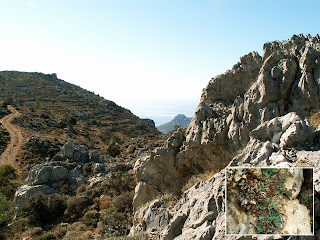I thought that as we walk down the next part of the
gully we’d have a look at air – there’s some, look, right in front of your
nose. You can’t see, smell, taste or touch it so what exactly is it? Mainly
it’s a mixture of two elements (not a compound – they don’t combine together).
The two elements are Nitrogen (78%) and Oxygen (21%). The other 1% contains
other elements, primarily Argon.
 |
| Rosularia serrata |
Every breath you take (don’t worry – I’m not going
to start singing again) is for the most part Nitrogen, a vital element for us
but the problem is; we can’t use it directly. We need plants to do a bit of
work for us like this Rosularia serrata
here. It can’t use Nitrogen from the air either, it needs help from special
bacteria in the soil that use enzymes to convert the nitrogen into organic
compounds that it takes up through its roots. We, and other animals, can then
take the nitrogen that we need to produce things like essential amino acids from
the plants that we eat. When it, and we, die we pass the nitrogen back into the
soil for reprocessing by bacteria.
 |
| Ferns and Mosses |
Air hasn’t always been air as we know it today and
if we go grubbing about down there in the dark and damp bits we should find a
couple of the major players in the events that led to the breathable stuff that
we enjoy today. About four hundred million years ago, when these ferns and
later these mosses, were the pioneering land plants oxygen was only running at
about 15% but plants, as we know, give off oxygen as a by-product of
photosynthesis and over the next hundred million years levels built up to about
35%, an abundance that gave rise to giant dragonflies and things. The rise of
oxygen breathing animal life brought the levels back down to a range which we’ve
evolved to function in which is about 19-24%.
 |
| Darkling and Rosemary Beetles |
We seem to have come out into the open air as it
were and it looks as if we’re at the head of the oleander highway (see Into The Woods) so we should be able to find some nice insect
life in there. We have beetles in abundance. This beefy, black job is the
brother of the one we found a couple of weeks back up the valley. That one was Raiboscelis coelestinus with the blue
sheen and this one is Raiboscelis corvinus.
The other two are Rosemary Beetles, Chrysolina
Americana, and they seem to be thinking about expending a bit of energy to
make more Rosemary beetles. Which brings me back to oxygen. The reason why it
so important to us and all other animals is that we need it to convert glucose
into energy in a complex process called catabolism[1]. Simply put,
we couldn’t move a muscle without it.
 |
| Ant nursery |
Apart from the composition of air there are two
other aspects of it that are important and those are its temperature and
humidity, a delightful illustration of which you can see by looking under this
rock that I’ve just turned over. The little white cocoons that the ants are fussing
over are the larvae. These, along with
the eggs, they constantly move from one place to another within and just
outside of the nest to regulate their conditions as the temperature and
humidity fluctuate throughout the day and night. They really are the most
dedicated of nursemaids. But now it seems we have reached a defile through
which we cannot pass, not without ropes and crampons anyway. I suggest that we
walk back over the hill, down through the village of Agios Ioannis and pick up
our route again a couple of hundred feet lower down.
| Cumulus and Cirrus clouds |
Just look at that wonderful cloudscape above us. The
large, fluffy one is a cumulus cloud (from Latin, meaning heap) while the
streaky ones above are cirrus (from Latin, meaning a ringlet of hair). There
are sixteen major cloud types in total, all of which contain water vapour in
varying amounts evaporated from the Earth’s surface. You may be wondering; if
air is 78% nitrogen and 21% oxygen how come your hygrometer says that its 60%
water? Firstly it’s because those percentages are for perfectly dry air and
secondly that your hygrometer is measuring relative humidity; the partial
pressure of water in the air compared to what it could be if it was fully
saturated, and not the actual amount of water in the air. Which is a good
indicator of whether it is likely to rain or not and thus of far more practical
use as a measurement.
So that’s air, in a nutshell. Meanwhile I think I
can see the village below us so we’ll explore that next week.
The Extra Bit
I've just started a magazine called The Nature of Crete on Flipboard. Eventually it will not only contain links to the latest blog but other articles and blog posts about the flora and fauna of the island. If you'd like to read it and maybe even contribute a link then this is the web address: The Nature of Crete
***********************************************************************************
LINKS:
Naturalists
(the facebook page that accompanies this blog)
See detailed pictures at
http://www.inaturalist.org/login (search - people-stevedaniels-observations)
The Nature of Crete (Flipboard Magazine)



No comments:
Post a Comment